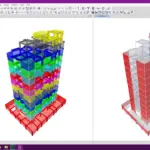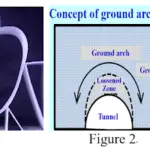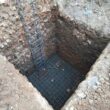Want to know what is chain surveying? – You must be lucky that you found this page
“Because”
Here I’m going to explain to you everything about chain surveying like
- Principle of chain surveying
- Different types of lines that are used in chain surveying like base line, check line, tie line
- Different types of offsets in chain surveying
- Then I’ll be explaining step by step procedure for chain surveying
- As a bonus tip; I’ll give you some tips on how to record the measurements effectively in the field book after chain surveying.
So stay tuned and let’s get drowned.
Although chain surveying is not listed amongst the most accurate methods of field surveying but it is the simplest method of surveying.
It is a method of surveying in which only linear measurements are taken and no angular measurements are made.
So we can say that it is the mostly suitable for small areas that are plane and does not have many details to show.
In details mostly man made or natural features are shown that are at or near the ground surface.
You might be wondering; why chain surveying is not accurate? So hang on dear I’ll give its answer later in the post.
What is Chain Surveying?
In chain surveying chains of different types and lengths are used to measure and record series of linear distances on ground. In land measurements link types surveying chains of 30 meters lengths are frequently used in countries like India and Pakistan.
[su_box title=\”Pro Tip\” style=\”bubbles\” box_color=\”#22c55e\” radius=\”5\”]The use of chain has its own pros and cons that must be considered while adopting any method of surveying.[/su_box]
Chain is robust, easily read and easily repaired in the field if broken. But it does not give correct length owing to wear on the metal to metal surfaces, bending of links, mud between the bearing surface etc.
And the biggest disadvantage is its weight which is difficult to carry and suspend.
Types of Chains used in surveying
I am not going to explain in detail about different types of chains that are used in surveying; as a resource you can watch this link. However, the most common types of chains used are
Like Us on Facebook!
- Metric chain
- Non-Metric chain
- Gunter’s chain or Surveyor’s chain
- Engineer’s chain
- Revenue chain
- Steel band
Subscribe Us on YouTube!
For more accurate and precise survey work tapes are used instead of chains.
[ctt template=\”2\” link=\”59rd0\” via=\”yes\” nofollow=\”yes\”]The tapes and chains were used when electronic distance measurement (EDM) devices like geodimeter, mekometer and range master or microwave equipments were not developed.[/ctt]
You would also like to read about What is Compass Surveying?
Instruments
The small instruments and accessories that are used for executing chain surveying are as follows :-
- Arrows
- Pegs
- Ranging Rods
- Offset Staff / Rods
- Plum Bobs
Arrows or sometimes chain pins are used to mark the position of the ends of the chain on the ground.
[su_box title=\”Pro Tip\” style=\”bubbles\” box_color=\”#22c55e\” radius=\”5\”]The wooden pegs are used to mark the positions of the survey stations or the end points of survey line.[/su_box]
The typical dimensions for wooden pegs are 25 mm x 25 mm in cross section and 150 mm long with nail at the top.
Ranging poles and rods are used to make measurements along a straight line. Plumb bobs are used to project a point on the ground up to the chain or to project a point on the chain down to the ground.
The activity of chaining is the process of measuring the distance with the chain and the distance obtained is termed as chainage. Chainage (running distance) is the distance along a curved or straight survey line from a fixed commencing point, as given by an odometer.
Suitability of Chain Surveying
The chain surveying is suitable in the areas that met the following conditions :-
- It is suitable when the ground is fairly level and open with simple details.
- When large scale plans are needed, this type of survey is not suitable.
- It is suitable when the area to be surveyed is comparatively small in extent.
- It is suitable for ordinary works as its length alerts due to continued uses
- Sagging of chain due to its heavy weight reduces the accuracy of measurements.
- It can be read easily and repaired in the field itself.
- It is suitable for rough usage.
- It is suitable when well-conditioned triangle is easy.
However, chain surveying is not recommended in the areas that are over-crowded with many details or the area is very large with too many undulations.
Principle of Chain Surveying
The principle of chain surveying is triangulation i.e. to divide the area into number of triangles of suitable sides.
A network of triangles is preferred here as triangle is the simple plane geometrical figure which can be plotted with the lengths of its sides alone.
In this case, there is no need for measuring angles. Due to consideration of triangles the chain surveying is also sometimes referred as triangulation.

Procedure of Chain Surveying
The procedure of chain surveying is very simple and straightforward. It does not involve any complex process. There are three stages you have to go through while doing chain surveying these are :-
- Field Work
- Recording of data in Field Book
- Plotting of features on a map
The step by step procedure of chain surveying is explained below: –
The field work for chain surveying is further divided into three steps :-
- Chaining
- Ranging
- Offsetting
These three operations are done simultaneously during chain surveying field work.
The procedure for chain surveying is outlined below:-
Reconnaissance Survey
Reconnaissance survey is actually a preliminary step i.e. an overview of the area for determining what sort of features to cover in chaining and what features should be omitted. It is the preliminary inspection of the area to be surveyed.
Marking Stations
In chain surveying mostly two types of stations are marked at site. These stations are
- Main stations
- Tie Stations or subsidiary Stations.
Different stations in Chain Surveying
The main stations, as the name suggests, are those that are at the end of the main or base lines. These stations command the lines that mark the boundary of the survey.
Whereas tie stations are those that are selected on main survey lines when it is necessary to locate the interior detail such as fences or buildings etc.
Main station is a prominent point on the chain line and can be either at the beginning of the chain line or at the end or along the boundary.
Different lines in Chain Surveying
- Tie Lines
- Base Lines
- Check Lines
Marking and fixing Survey lines.
- A base line which is a chain line is fixed.
- The base line is aligned by ranging.
- The length of the line is measured by chaining.
- For this follower holds the zero ends of the chain and the leader drags the chain to an intermediate point on the line.
- The leader straightens the chain by jerking till the chain lies exactly over the line.
- The leader marks the end of the chain by driving the chain pin (arrow)
- The follower holds the zero end of the chain at the chain pin point again
- Thus the chaining is continued till the entire length is covered.
Taking Offsets
- For locating the details, lateral measurements are taken to the objects.
- These lateral measurements are called offsets.
- If the offset is at right angles to the base lint it is called perpendicular offset.
- If it is inclined to the base line it is called oblique offset.
- Depending upon the situation, perpendicular or oblique offsets are taken.
- The lengths measured are entered in a plane.
Advantages of Chain Surveying
The following are advantages of chain surveying
- Chain survey is simplest and commonest method used in surveying exercises
- The equipment used to conduct chain survey are simple to use,
- The equipment used in chain survey can easily be replaced. For example measuring rods can be replaced with measuring tape.
- This method does not involve complicated mathematical calculation. I know this is the relief to those who are afraid of mathematics
- In chain survey few people are needed to conduct the survey. Normally chain survey team has three people Booker, leader and follower.
Disadvantages of Chain Surveying
The following are disadvantages of simple chain survey
- Simple chain survey cannot be conducted in built up areas and large areas.
- Simple chain survey is subject to several chances of errors of accumulation which may be caused by problem of chain. The chain linkage may fail to stretch up properly and result in inaccurate data. Also clogging of chain may read to error in reading.
- It is time consuming
- It may not be conducted in areas with steep slopes or water logged areas.chain survey is usually conducted in dry areas with gentle slopes. It becomes more complicated when survey is conducted in areas that are too wet.
- Chain survey becomes more complicated method when there are raised points (obstacles) in between areas to be surveyed
Errors in Chain Surveying
The different types of errors that needs to be considered in chain surveying are:-
- Compensating Errors
- Cumulative Errors
- Personal Errors
- Natural Errors
Compensating Errors:
Which are liable to occur in either direction and tend to compensate
Cumulative Errors:
Which occur in the same direction and tend to add or subtract? It may be positive (measured lengths more than the actual length) or negative (measured lengths less than the actual length)
Personal error:
Bad ranging (Cumulative Errors). Careless holding (CompensatingErrors). Bad straightening (Cumulative Errors). Non- horizontality (Cumulative Errors).Sag in chain(Cumulative Errors). Miscounting and misreading and booking.
Natural Errors
Variation in temperature. (Cumulative Errors)















